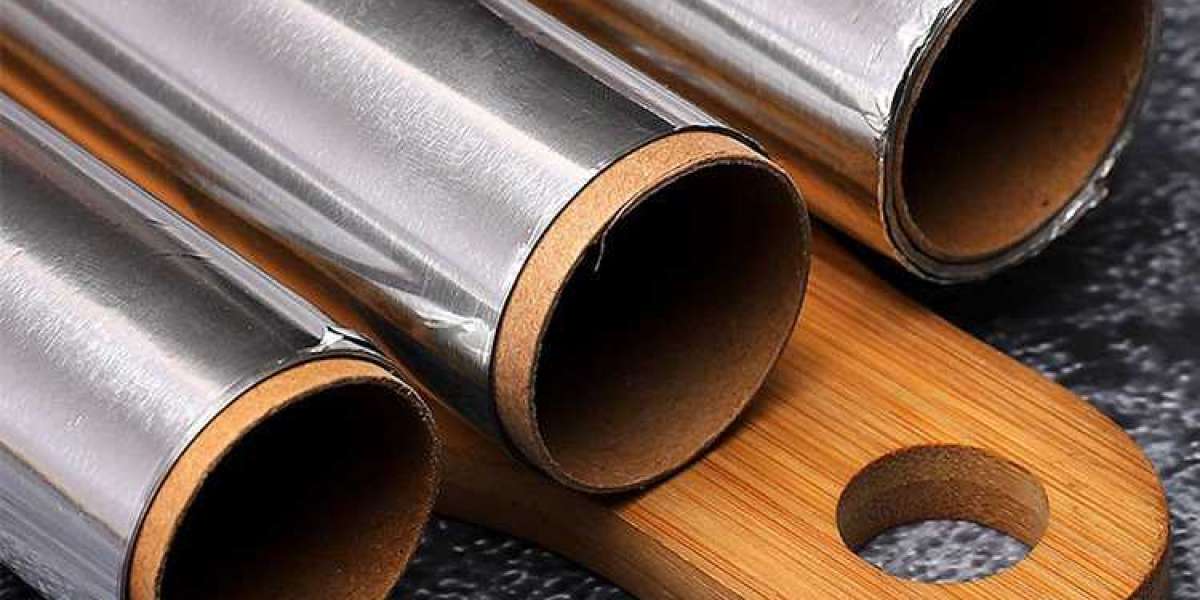Aluminum foil is made from an aluminum alloy which contains between 92 and 99 percent aluminum. Usually between 0.00017 and 0.0059 inches thick, foil is produced in many widths and strengths for literally hundreds of applications. It is used to manufacture thermal insulation for the construction industry, fin stock for air conditioners, electrical coils for transformers, capacitors for radios and televisions, insulation for storage tanks, decorative products, and containers and packaging. The popularity of aluminum foil for so many applications is due to several major advantages, one of the foremost being that the raw materials necessary for its manufacture are plentiful. Aluminum foil is inexpensive, durable, non-toxic, and greaseproof. In addition, it resists chemical attack and provides excellent electrical and non-magnetic shielding.
Shipments (in 1991) of aluminum foil totaled 913 million pounds, with packaging representing seventy-five percent of the aluminum foil market. Aluminum foil's popularity as a packaging material is due to its excellent impermeability to water vapor and gases. It also extends shelf life, uses less storage space, and generates less waste than many other packaging materials. The preference for aluminum in flexible packaging has consequently become a global phenomenon. In Japan, aluminum foil is used as the barrier component in flexible cans. In Europe, aluminum flexible packaging dominates the market for pharmaceutical blister packages and candy wrappers. The aseptic drink box, which uses a thin layer of aluminum foil as a barrier against oxygen, light, and odor, is also quite popular around the world.
Aluminum is the most recently discovered of the metals that modern industry utilizes in large amounts. Known as "alumina," aluminum compounds were used to prepare medicines in ancient Egypt and to set cloth dyes during the Middle Ages. By the early eighteenth century, scientists suspected that these compounds contained a metal, and, in 1807, the English chemist Sir Humphry Davy attempted to isolate it. Although his efforts failed, Davy confirmed that alumina had a metallic base, which he initially called "alumium." Davy later changed this to "aluminum," and, while scientists in many countries spell the term "aluminium," most Americans use Davy's revised spelling. In 1825, a Danish chemist named Hans Christian Ørsted successfully isolated aluminum, and, twenty years later, a German physicist named Friedrich Wohler was able to create larger particles of the metal; however, Wohler's particles were still only the size of pinheads. In 1854 Henri Sainte-Claire Deville, a French scientist, refined Wohler's method enough to create aluminum lumps as large as marbles. Deville's process provided a foundation for the modern aluminum industry, and the first aluminum bars made were displayed in 1855 at the Paris Exposition.
At this point the high cost of isolating the newly discovered metal limited its industrial uses. However, in 1866 two scientists working separately in the United States and France concurrently developed what became known as the Hall-Héroult method of separating alumina from oxygen by applying an electrical current. While both Charles Hall and Paul-Louis-Toussaint Héroult patented their discoveries, in America and France respectively, Hall was the first to recognize the financial potential of his purification process. In 1888
The Bayer process of refining bauxite consists of four steps: digestion, clarification, precipitation, and calcination. The result is a fine white powder of aluminum oxide.
The Bayer process of refining bauxite consists of four steps: digestion, clarification, precipitation, and calcination. The result is a fine white powder of aluminum oxide.
he and several partners founded the Pittsburgh Reduction Company, which produced the first aluminum ingots that year. Using hydroelectricity to power a large new conversion plant near Niagara Falls and supplying the burgeoning industrial demand for aluminum, Hall's company—renamed the Aluminum Company of America (Alcoa) in 1907—thrived. Héroult later established the Aluminium-Industrie-Aktien-Gesellschaft in Switzerland. Encouraged by the increasing demand for aluminum during World Wars I and II, most other industrialized nations began to produce their own aluminum. In 1903, France became the first country to produce foil from purified aluminum. The United States followed suit a decade later, its first use of the new product being leg bands to identify racing pigeons. Aluminum foil was soon used for containers and packaging, and World War II accelerated this trend, establishing aluminum foil as a major packaging material. Until World War II, Alcoa remained the sole American manufacturer of purified aluminum, but today there are seven major producers of aluminum foil located in the United States.








